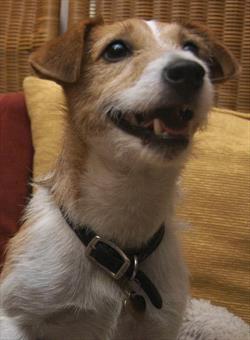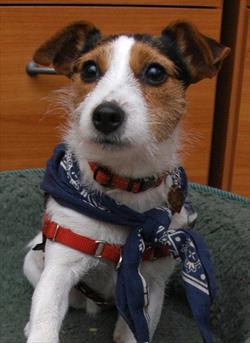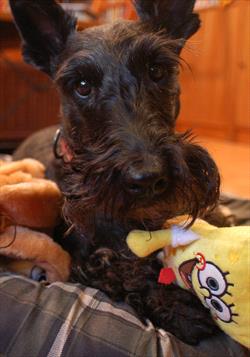In the last blog I summarized a research study (A comparative approach to dogs’ (Canis familiaris) and human infants’ comprehension of various forms of pointing gestures by Gabriella Lakatos, et. al.) that found dogs can use human pointing cues to infer the location of food. The dogs in the study chose the correct location 80% of the time if the human pointed with a straight arm. In fact, according to the study, dogs could even infer location if the pointing was with the leg or elbow but only somewhat (about 65% of the time).
To see whether this could possibly be true, I decided to test it out on my own dogs—Jonesy, then a 3 year old Jack Russell terrier (JRT) and his JRT sidekick, a foster dog named Homer. I actually think it’s unlikely that dogs who have never been exposed to pointing at all will respond appropriately to the cue. Most dog I know, tend to sniff your hand the first time they see you point. However, all dogs that have lived with me do get practice learning that I point a lot towards dropped food. So, I thought Jonesy and Homer might do well.
Training the Dogs to Find the Food Hidden in a Bowl:
Our training session started out great. I set the situation up similarly to the research study, except that I verbally told each dog to run to the “start position” rug and lie down on cue. Both Jonesy and Homer already knew this behavior well and, by doing this, I didn’t have to hold them in place. I also used rice bowls instead of plastic flower pots for the food.
I started with Jonesy. When he saw which one I plopped the treat into, he looked at the bowl. When I gave the verbal “ok” to get up and do what he wanted, Jonesy immediately went to the correct food bowl—twice. I made sure I did this with each bowl. Then I repeated the trial, but this time put the food on the ground and covered it with the bowl. That is, I lifted both food bowls so Jonesy could see which one had the food. When given the “ok” he reliably went to the correct food bowl. Yay! So, he could remember for up to several seconds where food was placed regardless of which food bowl I placed the food in. Homer responded the same way.
Testing Jonesy
Next, I hid the food when Jonesy was out of the room in the bowl on the right or the left. I performed the distal point, and not surprisingly, he went to the correct one. I wasn’t that surprised. As I said, dogs living with me are exposed to pointing towards food. But on top of that, I had also trained Jonesy that if I just point with my index finger 90º to the right or left, he should look left or right—whichever direction I’m pointing–even though my arm is not extended. You might think that means Jonesy is really smart, but it turns out he doesn’t understand the actual concept of looking in the direction that the finger is pointing; he just understands that one hand configuration means look left and another means look right. If I were to point up to the ceiling or down to the ground, he wouldn’t necessarily understand to look those ways. So even though people say Jack Russell Terriers are smart, I knew his cognitive function was not astounding. Rather, he learns things quickly because he moves fast enough so that we can get a lot of repetitions in a short amount of time.
Now came the eye opener. I continued to repeat the exercise five more times, and then Jonesy started messing up! He’d even look in the direction where I pointed and then go to the other bowl like he didn’t really believe that my pointing was relevant to where he thought the food was. I even repeated this in a second session and had the same response. His performance was sporadic.
Next I tried Homer, a foster dog that I had been stuck with for months. While Homer was not the most brilliant dog, either, both he and Jonesy had outsmarted their previous owners many-a-time. Plus, like Jonesy, Homer knew lots of tricks and had lots of practice paying attention to me. Things went great during the training phase and for the first trial using distal pointing. But then on subsequent repetitions, his response was random. In fact, he went back to the same empty bowl on 3 successive trials. That is, when he messed up, I sent him back to his rug, then pointed again and released him, and he went to the same wrong bowl. It’s like he must have thought I secretly put the treat in that wrong bowl during the 2 seconds when he had his back turned to me while going back to his rug.
Testing a Scottie, Named Meggie
Needless to say, I was a little puzzled by Jonesy and Homer’s poor response. So, before giving up, I tried my parents’ dog, Meggie, a 13 year old Scottish terrier.
Meggie’s results were completely different. 80% of the time when I pointed to the bowl on the left or the right, she looked in the appropriate direction and ran to the appropriate bowl. She performed as well as the study dogs.
So What’s Up with My Dogs?
I’m not absolutely sure why the dogs responded as they did, but I have several hypotheses as to why my dogs performed differently from the dogs in the pointing study:
Hypothesis 1: Pointing Means Nothing to Them
It could be that for Homer and Jonesy, pointing truly means nothing. But the problem is they sometimes clearly looked towards the object I was pointing to and then chose to go in the other direction.
Hypothesis 2: They’ve learned to ignore pointing?
Another hypothesis is that I point so much they have learned to ignore it sometimes. Dogs frequently learn to ignore our body language cues. In fact, when I designed and performed a scientific study for the MannersMinder/Treat&Train Dog Training system, to train dogs to run to a rug and remain lying down when guests come to the door, I was very focused on all the little gestures and cues people might give. As a result, in the training protocol I emphasized that owners should train the word, “place” (run to and lie down on the rug) without pointing so the dogs could just focus on the word. Owners couldn’t help themselves. They pointed reflexively during the clinical trial, and when watching the dogs, it was clear the pointing was either a distraction, or they didn’t even notice. It was easy for the dogs to be oblivious to the pointing because about 80% of the time dogs weren’t even looking at the pointing hand or arm as the human pointed.
Hypothesis 3: They see the point cue but don’t care or they don’t believe me.
A third hypothesis is that Jonesy and Homer see the pointing and just don’t care or they don’t believe that I have the right answer. They believe they know better. This would make some sense given their personalities. As a JRT, Jonesy is very independent, whereas Meggie is more focused on humans and taking guidance. But that still doesn’t quite describe Homer, a JRT too. While energetic and completely unbonded to his previous set of owners, I found him to be quite sweet, attentive to humans and interested in doing what I asked of him.
Hypothesis 4: Not enough practice trials
Then, there’s the idea that maybe my dogs needed more practice trials. They had learned that if they go to the correct bowl they get the treat but they didn’t have a chance to learn that going to the wrong bowl meant they got nothing. Although the study by Lakatos only had a short training session, perhaps, some dogs needed more training.
Whatever the cause, the results say something interesting; perhaps the researcher of the original study should test JRTs.
Epilogue:
Fast forward 2 years, Jonesy’s now 5 years old. I recently trained Jonesy the match to sample trick. Meaning that if I show him an object, he should be able to go and fetch me an identical object. As part of the training I think I came up with the answer to the results of his performance in the pointing study. To find the answer, stay tuned for the next blog.







